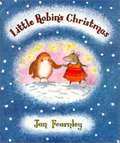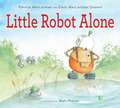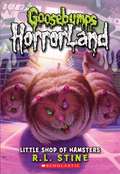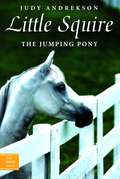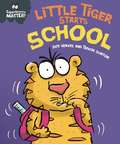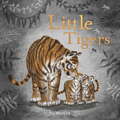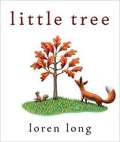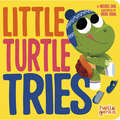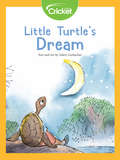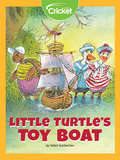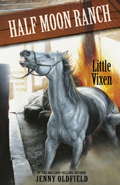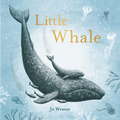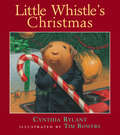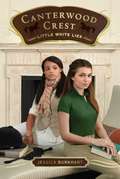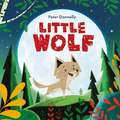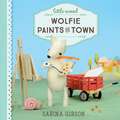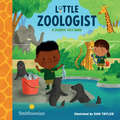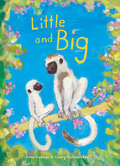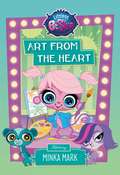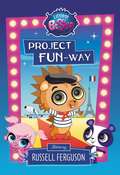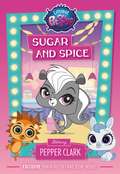- Table View
- List View
Little Robin's Christmas
by Jan FearnleyA short read-aloud book which illustrates the spirit of Christmas giving as it counts down the seven days before Christmas. Having given away all his warm vests to his cold animal friends during the week before Christmas, Little Robin receives a special reward from Santa. Here is a Christmas tale about how the little brown robin got its red breast. Pictures are described.
Little Robot Alone
by Matt Phelan Patricia MacLachlan Emily MacLachlan CharestIn this charming picture book by Newbery winner Patricia MacLachlan, Little Robot is lonely—until he has an inventive and creative solution. Little Robot’s life is peaceful—yet maybe it’s a little too peaceful. But wait! He has an idea. With a little hard work, perseverance, and resourceful thinking, can Little Robot build his way to the perfect cure for loneliness?
Little Shop of Hamsters (Goosebumps HorrorLand #14)
by R. L. StineSam Waters is desperate to have a pet. But his parents say that first Sam must prove he is responsible. So he takes an after-school job at a pet store called Little Shop of Hamsters. To his horror, Sam soon finds that cute, little hamsters can become very uncute monsters. Suddenly Sam isn't fighting for a pet-- he is fighting to survive! Could the souvenir he got from Horrorland have anything to do with it?
Little Squire: The Jumping Pony (True Horse Stories)
by David Parkins Judy AndreksonLittle Squire was born in an Irish meadow on an early spring day. The colt was beautifully formed with strong, straight legs and a pretty head. But due to his small size, it was unlikely he would be more than a nice child's riding pony. By the following spring, the yearling was separated from his mother and turned out to pasture with the other weanlings. Little Squire wasn't happy to be away from his dam so he charged the high stone wall and cleared it easily. Little Squire had just shown an astonishing side of himself that would eventually bring him greatness. Over time, the young horse traded hands, crossed an ocean, and ended up on the American show-jumping circuit. That was when he met another diminutive Irish immigrant, Mickey Walsh. The two were inseparable until, at Mickey's request, Little Squire was retired at the top of his game, and while he was still sound. He went out in a blaze of glory, though, ending his last performance with Mickey by jumping a six-foot-two fence -- rider-less -- in front of a packed arena. During the war-torn 30s, Little Squire had given people something to cheer about.From the Trade Paperback edition.
Little Squirrel Wants to Play (Into Reading, Level E #12)
by Bradley BergeronNIMAC-sourced textbook
Little Tiger Starts School (Experiences Matter)
by Sue GravesLittle Tiger Starts School offers a gentle introduction to the experience of starting school for young children.This funny, charming story is the perfect way to introduce young children to the experience of starting school. Also included are suggestions for activities and ideas to talk through together to help children reflect on their own experiences.Little Tiger was getting excited about starting school, but then he began to worry. What if he didn't know what to do? What if he didn't make any friends? Luckily, his brother is on hand to help reassure him.The Experiences Matter series of picture books provide a gentle means of discussing experiences, boosting self-esteem and reinforcing good behaviour. Supports the Personal, Social and Emotional Development Area of Learning in the Early Years Foundation Stage, and is also suitable for use with children in KS1 and can be used to discuss values. Suitable for children under 5.
Little Tigers
by Jo WeaverTold through the eyes of a tiger and her two cubs, this beautiful book is a celebration of the love between parent and child, and the wonders of the natural world. There are humans in the jungle... So Mother Tiger and her cubs need to leave their den. Follow them on their journey through the deepest parts of the jungle, exploring its secret places, in search of somewhere warm and dry to lay their heads. A safe place. A new home.With evocative charcoal drawings and gentle, lyrical storytelling, Little Tigers has the feel of an instant classic. Perfect for fans of the BBC's Planet Earth, this beautiful book will inspire young nature lovers.Also by Jo Weaver: Little One, Little Whale
Little Tree
by Loren Long<p>In the middle of a little forest, there lives a Little Tree who loves his life and the splendid leaves that keep him cool in the heat of long summer days. Life is perfect just the way it is. <p>Autumn arrives, and with it the cool winds that ruffle Little Tree's leaves. One by one the other trees drop their leaves, facing the cold of winter head on. But not Little Tree—he hugs his leaves as tightly as he can. Year after year Little Tree remains unchanged, despite words of encouragement from a squirrel, a fawn, and a fox, his leaves having long since turned brown and withered. As Little Tree sits in the shadow of the other trees, now grown sturdy and tall as though to touch the sun, he remembers when they were all the same size. And he knows he has an important decision to make. <p>From #1 New York Times bestselling author Loren Long comes a gorgeously-illustrated story that challenges each of us to have the courage to let go and to reach for the sun.
Little Turtle Tries (Hello Genius)
by Michael DahlIt’s time to get dressed, which is no easy task for Little Turtle! But Little Turtle will not give up. Keep on trying, Little Turtle!
Little Turtle's Big Adventure
by David HarrisonLittle Turtle awakes one day to the sound of bulldozers near his pond. He takes to the figurative road to find a new home. After a long journey through meadows, forests, and the like, he hibernates for the winter. In the spring, a boy picks him up and carries him to a new pond.
Little Turtle's Dream
by Valeri GorbachevLittle Turtle spends his nights in the backyard, looking at the stars and dreaming of becoming an astronaut.
Little Turtle's Toy Boat
by Valeri GorbachevPapa Turtle made Little Turtle a toy boat! He can’t wait to go sail it on the pond with his friends, the Duckling Twins and Dragonfly.
Little Vixen: Book 10 (Horses of Half Moon Ranch #10)
by Jenny OldfieldBrad Martin, a famous reining expert, visits Half Moon Ranch with his champion horse, Little Vixen. Kirstie adores the horse but is suspicious of the man - especially when she sees him getting close to her mother. She's heard he's fallen on hard times and is worried he's after a share of the Half Moon profits. Her worry turns to alarm when a sudden fire traps Little Vixen in the barn. Is Martin to blame? If so, why would he put his own horse in danger? Kirstie aims to untangle the truth from the lies...
Little Whale
by Jo WeaverTold through the eyes of a whale and her calf, this mesmerisingly beautiful book is a story of migration, family and the strength of parental love. And a celebration of the wonders of nature."We're going on a long journey, Little Whale," sang her mother. "We're going home."Travelling from the warm weather of the south, through fragile coral reefs, kelp forests and glittering shoals of fish, Little Whale follows her mother to the icy north. With her mother guiding and protecting her all the way home.With atmospheric charcoal drawings and gentle, lyrical storytelling, Little Whale is perfect for sharing with your little one."Evocative charcoal drawings bring the underwater world to stunning life; fans of Blue Planet will be mesmerised." The BooksellerAlso by Jo Weaver: Little One, Little Tigers
Little Whale in Deep Trouble: A Story Inspired by a True Event
by Hans WilhelmYoung children will be riveted by the story of Little Whale, a young calf who goes everywhere with his Mama.Every day as they swim through the waves, Little Whale feels happy and safe whenever he sees their shadows side by side on the ocean floor. One day, Little Whale sees a school of stingrays cruising by and he quickly races after them. He doesn't think he's gone too far when he suddenly looks down and sees only one shadow! Mama Whale is nowhere to be found…and he's stuck in a big fishing net! Now Little Whale is in deep trouble! Children will race to the end of this story to learn the outcome, discovering the real-life story that inspired this entertaining book. Little Whale in Deep Trouble includes lots of engaging facts about Humpback Whales that will encourage kids to learn more about these gentle giants. It's an excellent resource for children as they strive to meet state standards in English Language Arts. Pssst…it's a fun read
Little Whistle's Christmas (Little Whistle)
by Cynthia Rylant Tim BowersIt's Christmastime in Toytown. Lights are twinkling, bells are jingling, and children can't wait for Santa and his sleigh to arrive. Presents are wonderful, of course, but Little Whistle and his friends need something else for Christmas. Will Santa answer their letter and make their wishes come true? In Little Whistle's first holiday adventure, Newbery Medalist Cynthia Rylant and artist Tim Bowers once again bring the cozy world of Toytown to life--and capture the magical spirit of Christmas.
Little White Lies: Take The Reins; Chasing Blue; Behind The Bit; Triple Fault; Best Enemies; Little White Lies; Rival Revenge; Home Sweet Drama; City Secrets; Elite Ambition; Scandals, Rumors, Lies; Unfriendly Competition; Chosen; Initiation; Popular; Comeback; Etc (Canterwood Crest #6)
by Jessica BurkhartA LITTLE WHITE LIE NEVER HURT ANYONE...RIGHT? Sasha is with Eric. Callie is with Jacob. And Callie and Sasha are finally BFFs again. Life is as perfect as it's ever been at Canterwood. So when Sasha learns of a secret that could destroy all of her relationships, she's willing to tell a few white lies to keep everything from falling apart. After all, white lies aren't supposed to hurt anyone....
Little Wolf
by Peter DonnellyWhile all the wolves in the valley are busy preparing for the for the big Howling Ceremony, Little Wolf is afraid to use his voice. Little Wolf thinks he'll never find his howl - but then some wise words from Big Wolf remind him that even the smallest voice can make the sweetest sound. An inspiring, heartfelt tale for little pups everywhere about having the courage to find your own voice - even if it makes you stand out from the pack. From NUMBER ONE bestselling author-illustrator, Peter Donnelly.
Little Wood: Wolfie Paints the Town (Little Wood #1)
by Sabina GibsonWelcome to Little Wood, the tiniest town around! The first in a new picture-book series from innovative textile artist and photographer, Sabina Gibson. Wolfie is a little shy, but she loves to paint. Her friends and neighbors all want to see what she is working on, but she is not ready to share just yet. As she makes her way around Little Wood, she meets Bear, Rabbit, and Badger and paints them as they go about their day. Soon she is brave enough to show everyone what she has been doing—and the whole town is invited to her art show! Who did Wolfie paint? And what will she paint next? In the vein of Sylvanian Families, Calico Critters, and Richard Scarry, Wolfie Paints the Town introduces four lovable characters and the charming town of Little Wood, a place readers will want to visit again and again."An artful addition for maker spaces, craft classes, and anyone trying to spark creativity in the very young."--School Library Journal"Young readers and listeners will embrace this sweet, soft world that&’s full of warmth and friendliness and look forward to the offerings that follow. A nice choice to encourage kids to explore their own neighborhoods."--Kirkus
Little Zoologist (A Science Tots Book)
by Dan TaylorTeach your baby all about being a zoologist with this new board book published in partnership with Smithsonian.Scales. Notebooks. Habitats. Microscopes. Zoologists do a lot more than just feed and take care of animals and now young babies and toddlers will be able to learn all about what it means to be a zoologist and what tools they use as part of their job in this exciting and fun book in a new board book series published in conjunction with the Smithsonian Institute.
Little and Big
by Anne GutmanTwo lemurs–one little and one big–take turns wishing to be more like the other, in this lush, poignant picture book about life with a sibling set in the rainforest of Madagascar.It&’s nighttime in the rainforest, and when Mama tells young Faly to shut his eyes, he objects. &“Only if Mahandry sleeps, too,&” he tells his mother. &“But I am bigger than you, Faly,&” answers the older lemur brother. &“I am allowed to go to bed later.&” Thus begins a spirited back-and-forth and a family gambol that brings a mama and her two lemur sons from the hollow of their tree to a dangerous wide river crossing to a slippery rushing waterfall and eventually to a tall tree filled with orchids to snack on. And with each step, the brothers notice who gets help from mama or who gets the kind of independence that comes with being big. Each child desires both, and each child quietly reflects throughout on why he would rather be more like the other. No matter, it always seems true to one brother that the other has the advantage.Anne Gutman&’s poignant tale of siblings seesawing through a typical day en famille rings with truth, humor, and sensitivity. Georg Hallensleben's paintings of the rainforest in pinks, browns, and greens are a feast for the eyes and a treat for nature fans, and especially for young readers being introduced to the magic of the rainforest and its inhabitants for the first time.
Little-or-Nothing from Nottingham
by Marguerite HenryWhen the little white dog was caught by a guard sneaking into the circus tent, and it was found that he could do tricks, he was adopted by the circus Treasurer and his husband. Named Little-or-Nothing the dog soon proved to be a great act. But when Little-or-Nothing suspects people from stealing his bones, will he still perform? Can he be happy again in the circus? And where have all those bones gone to? All images are described for the reader.
Littlest Pet Shop: Art from the Heart
by Ellie O'RyanThe third chapter book in the Littlest Pet Shop series, starring Minka Mark, an artistic, energetic monkey who must settle down and focus to create her most high-profile work yet! © 2016 Hasbro. All Rights Reserved.
Littlest Pet Shop: Project FUN-way
by Ellie O'RyanThe second original chapter book in the Littlest Pet Shop series, starring Russell Ferguson, a level-headed hedgehog who finds himself becoming a prickly diva when tasked with overseeing a fashion show! © 2015 Hasbro. All Rights Reserved.
Littlest Pet Shop: Starring Pepper Clark (Littlest Pet Shop Ser.)
by Lisa SheaA brand new chapter book featuring Pepper Clark from Littlest Pet Shop! When the Pawristas coffee shop is planning for a big "two for one" weekend, the pets offer to help Blythe, especially Pepper Clark. With a few bites from a glazed doughnut, Pepper's productivity astonishes everyone. However, Blythe warns the sweets-loving skunk that a little sugar goes a long way. Pepper, on the other hand, believes that if a little sugar makes her feel a little better, then a lot should make her feel a lot better! Can Pepper continue to impress her friends or will things finally get out of hand?© 2016 Hasbro. All Rights Reserved.
